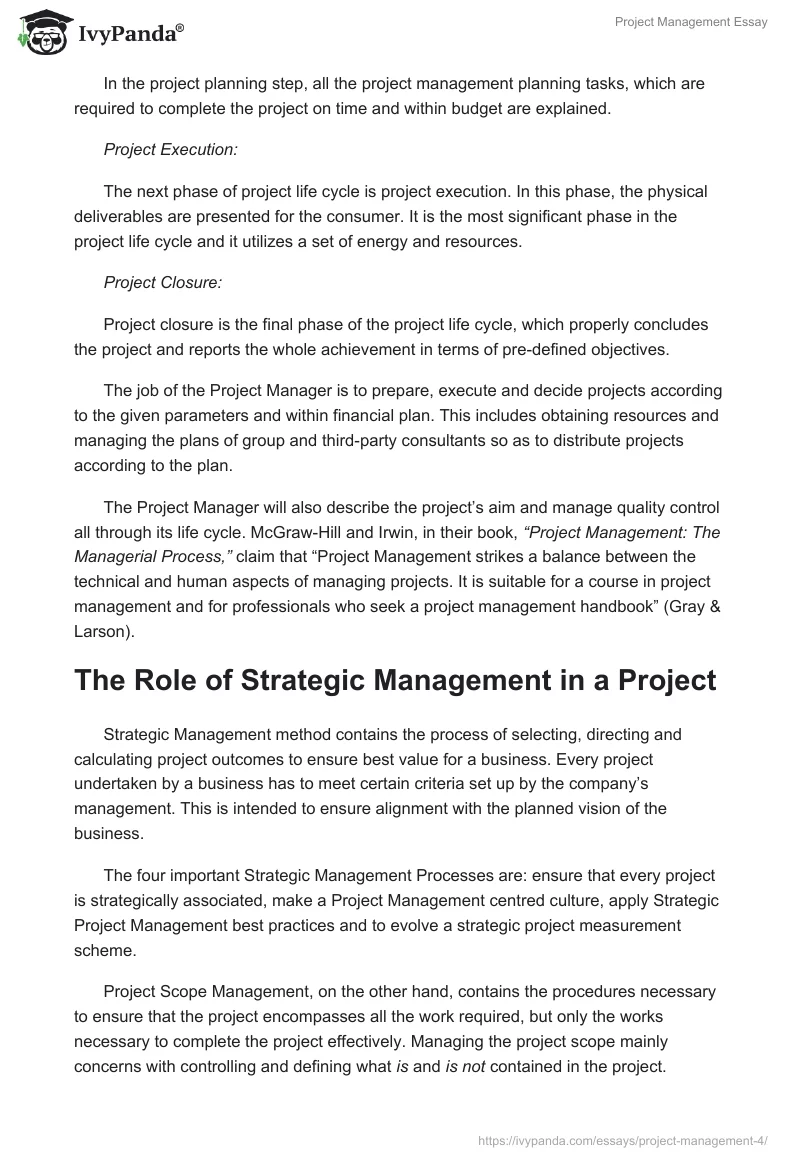Why study project management? This essay gives an answer to the question. It explains the importance and benefits of planning as a business process and a research topic. Write an A+ essay on product management with this example!
Introduction
Project management is a discipline of planning, controlling, securing and organizing resources to attain specific objectives. A project can be perceived as an impermanent endeavour with a defined starting and end, undertaken to convene unique objectives and goals, normally to bring about useful change.
The impermanent nature of projects differs from business to business. In some cases it can be permanent, or semi permanent, repetitive functional actions to produce services or products. “A project is a unique endeavour to produce a set of deliverables within clearly specified time, cost and quality constraints” (Westland 2).
Project Management Phases
All projects can be thought of as a series of phases that have specific beginnings and defined endpoints. Project management life cycle has mostly four phases namely project initiation, project planning, project execution and project closure. All of the phases of the project life cycle have lot of activities to play. These are described in the following segment.
Project Initiation
This is the initial phase of the project life cycle, which, in turn, has a group of activities which are to be carried out prior to the planning stage. In this phase, the scope and purpose for initiating it and the solution to be found are described.
Project Planning
In the project planning step, all the project management planning tasks, which are required to complete the project on time and within budget are explained.
Project Execution
The next phase of project life cycle is project execution. In this phase, the physical deliverables are presented for the consumer. It is the most significant phase in the project life cycle and it utilizes a set of energy and resources.
Project Closure
Project closure is the final phase of the project life cycle, which properly concludes the project and reports the whole achievement in terms of pre-defined objectives.
The job of the Project Manager is to prepare, execute and decide projects according to the given parameters and within financial plan. This includes obtaining resources and managing the plans of group and third-party consultants so as to distribute projects according to the plan.
The Project Manager will also describe the project’s aim and manage quality control all through its life cycle. McGraw-Hill and Irwin, in their book, “Project Management: The Managerial Process,” claim that “Project Management strikes a balance between the technical and human aspects of managing projects. It is suitable for a course in project management and for professionals who seek a project management handbook” (Gray & Larson).
The Role of Strategic Management in a Project
Strategic Management method contains the process of selecting, directing and calculating project outcomes to ensure best value for a business. Every project undertaken by a business has to meet certain criteria set up by the company’s management. This is intended to ensure alignment with the planned vision of the business.
The four important Strategic Management Processes are: ensure that every project is strategically associated, make a Project Management centred culture, apply Strategic Project Management best practices and to evolve a strategic project measurement scheme.
Project Scope Management, on the other hand, contains the procedures necessary to ensure that the project encompasses all the work required, but only the works necessary to complete the project effectively. Managing the project scope mainly concerns with controlling and defining what is and is not contained in the project.
Conclusion
Project management must be viewed as a technique that enables the organisations to successfully execute selected projects efficiently and effectively. However, the use of this technique alone does not automatically guarantee project achievement.
Work Cited
Gray, Clifford F. & Larson, Erik W. Project Management. McGraw-Hill Publishing Limited. 2000. Web.
Westland, Jason. The Project Management Life Cycle: A Complete Step-by-Step Methodology for Initiating, Planning, Executing & Closing a Project Successfully. Kogan Page Limited. 2006. Web.
Project Management Essay FAQ
- Why is project management important?
Project management aims to plan and lead a project to successfully complete it. It involves several phases, each of which brings direction to a project, be it in the sphere of business, charity, or art. - Why study project management?
Project management is an exciting job that might lead to a fulfilling career in many spheres. Project management skills that imply the ability to successfully lead a project from its beginning to the conclusion, are always in demand in any company. - What is scope in project management?
Project scope means a common understanding between the project stakeholders about its boundaries, goals, and essential milestones. It is crucial to define the project scope and its key elements before you start working. - What is crashing in project management?
Crashing is a method in project management used to speed up the project’s timeline without changing its overall scope. Project crashing implies adding more resources to reach the highest possible efficiency level.


